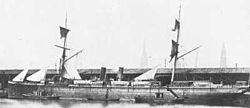Westphalia (ship, 1868)
|
The Westphalia after reconstruction in Hamburg in 1877/78
|
||||||||||||||||||||||
|
||||||||||||||||||||||
|
||||||||||||||||||||||
|
||||||||||||||||||||||
|
||||||||||||||||||||||
The steamship Westphalia was the third ship of the Hammonia class of the Hamburg-American Packetfahrt-Actien-Gesellschaft (Hapag).
A cargo ship of 3,079 GRT, which was used from 1899 to 1918 and was purchased as Sophie Rickmers , also bore the same name . The third bearer of the name on the Hamburg-America-Line was then from 1923 to 1930 a new building of 11,343 GRT, which was renamed General Artigas and was handed over to Hamburg-Süd in 1936. In the more modern form Westfalia , the type ship of the Westfalia class came into service with the shipping company in 1964 .
history
The ship was built by Caird & Company in Greenock in 1868 and entered service on the Hamburg-America Line on September 16, 1868. It offered 90 seats for first class passengers, 120 in second and 520 seats in third class. At first it had only one chimney and two sailing masts.
The Westphalia was used on the Hamburg- New York route. On July 9, 1870, in thick fog in the canal , she rammed the Norwegian brig Pravis , which sank immediately, but whose crew could be saved.
Illustrious charge
In 1871, were on the Westphalia the items for the Tyler-Davidson Fountain , in Bavaria had been made and in Cincinnati should be built, shipped to America - including 85 tons Bavarian granite. The two largest transport boxes could not be accommodated in the holds and had to be lashed to the deck.
In 1874, Westphalia reached Queenstown (Ireland) towing a Spanish steamer after its drive shaft broke on the return voyage.
Remodeling and further use
After a last round trip from April 28, 1875, it was launched in Hamburg, as Hapag had considerable excess capacity with its six modern steamers after purchasing the Adler line . The period of non-employment was used to modernize Westphalia at Blohm & Voss in 1877/78. She received new compound machines and two chimneys. From July 30, 1879, she was back on her old route.
Accidents and collisions
On August 8, 1882, the ship collided with the British State of Florida (3,158 GRT, 1874). In the same year, on the night of November 13th, Westphalia collided in the canal with the Belgian freighter Adrien David (1,163 GRT, 1870), which sank and his entire crew of 25 men were killed. Part of the crew of the Westphalia tried to come to her aid. According to the men's report, which appeared in the New York Times of November 15, 1882, the Belgian steamer went up in flames before sinking. The Westphalia itself was badly damaged when it reached Portsmouth harbor . According to the newspaper report, a large piece of the steamer she had collided with was stuck in her hull - which ship it was initially unknown. Apparently the Adrien David had first hit the port side of the Westphalia and then scraped along the starboard side of the ship and also tore it open.
In February 1883, the Westphalia took twenty passengers from the sister ship Cimbria , which had crashed in January, on board and brought them to New York.
On December 19, 1886, she started her 103rd and last trip in the service of HAPAG to New York.
Further service under the Italian flag
In 1887 it was sold to Armstrong / Mitchell in Newcastle and was named Atlantica .
A year later she was given a new name, Provincia di Sao Paolo , and now drove for Gazzo & Schiaffino in Genoa . In 1889 it was given to the Fratelli Lavarello and renamed Mentana . In 1890 it was taken over by the La Veloce shipping company, which also operates South America and used the ship as Sud America . Her home port during this rapid name change remained Genoa.
In 1901 the former Westphalia was scrapped in Genoa.
See also
- List of HAPAG ocean-going vessels 1848–1970
- Schiller (Schiff, 1873) regarding the ships of the Adler line
literature
- Walter Kresse (Hg.): Seeschiffs -verzeichnis der Hamburger Reedereien, 1824–1888 (= messages from the Museum of Hamburg History, NF, Vol. 5). Museum of Hamburg History, Hamburg 1969, Volume 1, p. 192.
- Arnold Kludas , Herbert Bischoff: The ships of the Hamburg America Line , Vol. 1: 1847-1906 . Koehler, Herford 1979, p. 28.
- Arnold Kludas: The history of the German passenger shipping, vol. 1: The pioneering years from 1850 to 1890 (= writings of the German shipping museum, vol. 18). Kabel, Hamburg 1986, ISBN 3-8225-0037-2 .
- Noel Reginald Pixell Bonsor: North Atlantic Seaway. An Illustrated History of the Passenger Services Linking the Old World with the New . Brookside Publications, Jersey, 2nd Edition, Volume 1, 1975, p. 390.
Web links
- Dates and history ( Memento from May 23, 2008 in the Internet Archive )
- Data on the Westphalia
- Datasheet at Clyde Built Ships
- Hapag shipping list
Footnotes
- ↑ http://www.theshipslist.com/ships/descriptions/ShipsWZ.shtml
- ↑ Archived copy ( memento of the original dated November 26, 2004 in the Internet Archive ) Info: The archive link was inserted automatically and has not yet been checked. Please check the original and archive link according to the instructions and then remove this notice.
- ↑ a b Westphalia, Hamburg America Line - Logbook , on www.norwayheritage.com. Retrieved November 10, 2009.
- ↑ Kludas, Vol. I, p. 104
- ^ Fall of Adrien David .
- ↑ Kludas, Vol. I, p. 44.
- ↑ http://query.nytimes.com/mem/archive-free/pdf?res=9904E1D8143DE533A25755C1A9679D94639FD7CF

